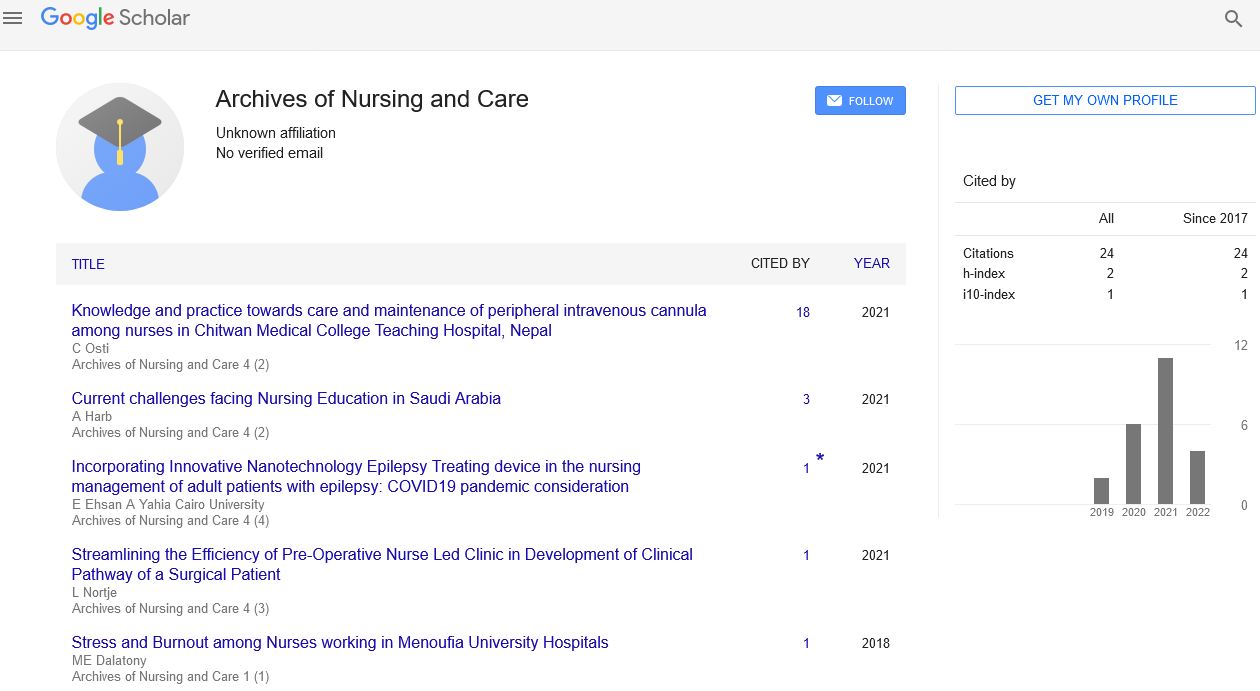Mini Review - Archives of Nursing and Care (2023) Volume 6, Issue 3
Clinical Nursing: Analysis and Evaluation of Nursing Intervention and Nursing in Critical Care.
Sergio Mendes*
Department of Gynecology, The First People’s Hospital of Lianyungang City, Jiangsu Province, China
Department of Gynecology, The First People’s Hospital of Lianyungang City, Jiangsu Province, China
E-mail: Mendessergio@edu.bx.it
Received: 02-June-2023, Manuscript No. OANC-23-96481; Editor assigned: 05-June-2023, PreQC No. OANC-23- 96481 (PQ); Reviewed: 19-June-2023, QC No. OANC-23-96481; Revised: 26-June-2023, Manuscript No. OANC-23- 96481 (R); Published: 30-June-2023; DOI: 10.37532/oanc.2023.6(3).49-51
Abstract
Intensive care units are systems organized for the provision of care to patients in critical situations. In general, it is suggested that intensive care consists of a multidisciplinary and interprofessional specialty. Nevertheless, the predominance, relative to the professions that incorporate these units, falls on nurses. A conceptual model of nursing provides a framework for reflection, observation, and interpretation of phenomena and, specifically, it provides guidelines and guidance for aspects of clinical practice.
Introduction
Being acute or critically ill is stressful for both patients and their kin, and these patients require continued help and support in concert with the best medical treatment. Modern intensive care is based on collaboration between professional groups; however, intensive care nurses are continually present with the patient in intensive care units (ICUs) to monitor their condition and coordinate their care [1]. Henderson defined a nurse's universal function as the responsibility of assisting the patient in covering their basic needs whilst being in vulnerable situations and helping the individual become independent of assistance. Henderson also proposed 14 components of basic nursing care that attend to the patient's physiological, psychological, spiritual and social needs. To take care of the whole person and their families, nurses in the ICU conduct independent interventions that attend to the patients' and their families' basic needs. These interventions are complex [2], multicomponent health services and may have many potential active ingredients; the question is which components contribute to the best outcomes.
Patientâreported outcome measures are standardized selfâreported data collection techniques focusing on the patient's health status. They highlight the patient's or their family's viewpoint rather than focusing on purely clinical outcomes, thereby improving patientâcentred care. Accordingly, nurses need to understand and use outcomes measured from both clinical and patient/family perspectives to guide their nursing practice and help tailor treatment to meet the patient preferences and needs in the ICU [3]. Understanding this issue refers to the role of concepts, which correspond to ideas and perceptions of a phenomenon that guide the understanding of facts and propositions that articulate concepts in the attempt to explain a phenomenon. Concepts and proposals constitute the conceptual framework, a tool to identify the knowledge action that constructs the scientific knowledge through reflection on the concepts that surround their work process. Identifying the elements that make up the conceptual framework of clinical nursing care in intensive care is critical because this offers better conditions to know how the practices in this sector are shaped and the meanings of the aspects that structure this framework and guide the actions. The objective is to propose a conceptual framework for clinical nursing care in intensive care. Method Descriptive and qualitative field research field based on the nursing meta-paradigm. The data was produced through individual interviews, applying a semi-structured script with open questions about the daily practice in the ICU, care style, use of technologies among others [4].
We conducted a pilot test of the instrument with ICU nurses from another institution to adapt the questions and check its functionality to reach the proposed goal. The interviews were held in the field of study, in the afternoon, and took an average one hour and thirty minutes, being electronically recorded. In view of this triangulation of the analysis techniques and the apprehension of the nursing metaparadigm, the characterization of the elements involved in the conceptual framework was organized in four areas: nursing - science and art; environment; human being and human being and health [5]. According to these axes, the ECUs generated in Alceste and the Registration Units taken from the content analysis, illustrate the descriptive presentation of the elements that make up the conceptual framework of nursing care in intensive care.
Discussion
The authors of the studies selected for this review analyzed several conceptual models of nursing, particularly their implementation in intensive care and application in the care of critically ill patients. In the study by Fawcett et al., three conceptual nursing models and their implementation in intensive care were evaluated, Levine’s Conservation Model, Neuman’s System Model, and Dorothea Orem’s Self-Care Model [6]. The authors state that, regardless of the model selected to guide the provision of nursing care, the application of a conceptual model of nursing in these environments provides holistic care to people who experience life-threatening situations and contributes to the improving the quality of care. It should also be noted that this model attaches great importance to the factors that influence the person and their health, an aspect that is of fundamental importance in intensive care. Sutcliffe also evaluated the applicability of the mead model in intensive care and concluded that this model, although not perfect, can be very useful to guide nursing practice, since it supports nursing knowledge and its objectives and beliefs, in addition to being practical and user friendly. In the study of Sommers, five participants present their opinions regarding the implementation of conceptual models of nursing in intensive care. The author concludes that, despite the unquestionable benefits of this model, the possibilities of achieving self-care in intensive care units are very limited, especially due to society’s global perception of critical illness, which attributes the responsibility of recovery to the health team [7]. However, despite this limitation, it is proven that the implementation of this model contributes to the promotion of personalized care and enhances the importance of the perception of the person as a whole.
Conclusions
There is no consensus on the implementation of a specific conceptual model of nursing in intensive care units. Some authors propose some models and identify several benefits of their implementation in intensive care, which include contribution to the provision of holistic care to people who experience life-threatening situations, promoting quality of care, improving care security, enabling an individualized approach and promoting personalized care, prioritizing the identification of nursing problems and interventions to be implemented, contributing to the organization of care, promoting the incorporation of scientific knowledge in clinical practice [8]. The authors of this review highlight the fact that, for the selection of a conceptual model for these contexts, the focus should be on the person and not on the philosophy that supports the model; the choice must fall on the model that is most appropriate to the patient. This includes the possibility of combining different models and must be made by the nursing team according to the nature of the care provided [9]. The conceptual model of Virginia Henderson and the mead model, an adaptation of the Roper, Logan, and Tierney Model, seem to be suitable options for implementation in intensive care, in combination or in isolation. Virginia Henderson’s model contributes to significant improvements in basic physical activities. The mead model suggests that the person is the centre of care and attaches enormous importance to the factors that influence the person and their health, besides being a model that can be extremely useful to guide nursing practice, since it supports nursing knowledge, and it is practical. Nevertheless, there are several conceptual models of nursing in addition to those that were analyzed by the authors of the studies included in this review, so it cannot be excluded that others can be successfully implemented in intensive care units. With the realization of this study, the authors confirm that few studies were carried out on the implementation of conceptual models of nursing in intensive care units, especially in the last two decades. The authors are unanimous in considering that more studies should be carried out, especially primary studies, with more significant samples [10].
References
- Furman CD, Rayner AV, Tobin EP.Pneumonia in older residents of long-term care facilities.American Family Physician. 70, 1495–1500(2004).
- El-Solh AA, Niederman MS, Drinka P.Nursing home acquired pneumonia: a review of risk factors and therapeutic approaches.Current Medical Research and Opinion. 26, 2707–2714(2010).
- Mills K, Nelson AC, Winslow BT et al.Treatment ofnursinghome-acquired pneumonia.American Family Physician. 79, 976–982(2009).
- Sarin J, Balasubramaniam R, Corcoran AM et al.Reducing the risk of aspiration pneumonia among elderly patients in long-term care facilities through oralhealthinterventions.Journal of the American Medical Directors Association.Current Medical Research and Opinion. 9, 128–135(2008).
- Marik PE, Kaplan D.Aspiration pneumonia and dysphagia in the elderly. 124, 328–336(2003).
- Zimm S, Wampler GL, Stablein Det al.Intracerebral metastases in solid-tumor patients: naturalhistoryand results of treatment.Cancer.48, 384–394(1981).
- Grunfeld E, Coyle D, Whelan Tet al.Family caregiver burden: results of a longitudinal study breastcancer patientsand their principal caregivers.CMAJ.170, 1795–1801(2004).
- Brouwers MC, Chambers A, Perry Jet al.Neuro-oncology Disease Site Group. Can surveying practitioners about their practices help identify priority clinical practice guideline topics?BMCHealthServ Res.3, 23-25(2003).
- Lee ST, Lui TN, Chang CNet al.Prophylactic anticonvulsants for prevention of immediate and early postcraniotomy seizures.Surg Neurol.3, 361–364(1989).
- Mintz AH, Kestle J, Rathbone MPet al.A randomized trial assess the efficacy ofsurgerytoradiotherapyin patients with a singlebrainmetastasis.Cancer. 78, 1470–1476(1996).
Indexed at,Google Scholar,Crossref
Indexed at,Google Scholar,Crossref
Indexed at,Google Scholar,Crossref
Indexed at,Google Scholar,Crossref
Indexed at,Google Scholar,Crossref
Indexed at,Google Scholar,Crossref
Indexed at,Google Scholar,Crossref

